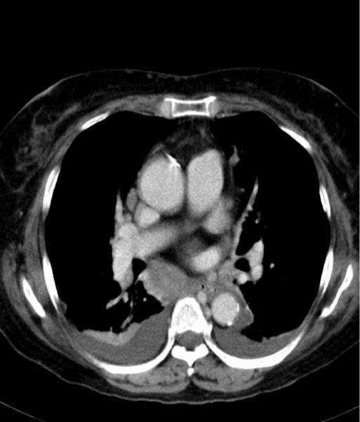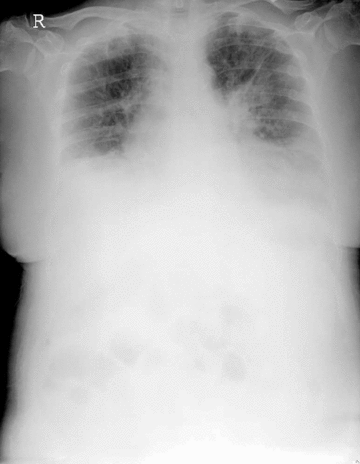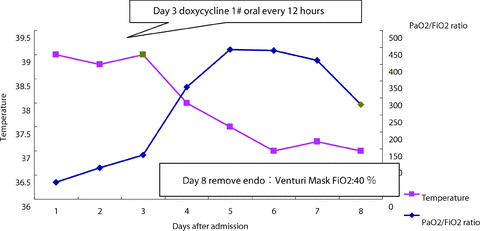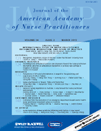Acute respiratory distress syndrome following scrub typhus: A case report
To obtain CE credit for this activity, go to http://www.aanp.org and click on the CE Center. Locate the listing for this article and complete the post-test. Follow the instructions to print your CE certificate.
Abstract
Abstract Purpose: To discuss a case of scrub typhus complicated with acute respiratory distress syndrome (ARDS) in a 67-year-old female. An overview of the prevalence and pathogenesis of the disorder, clinical diagnosis, and treatment are presented.
Data sources: Case report, diagnostic evidence, and scientific literature.
Conclusions: If not properly treated, scrub typhus can cause serious complications, such as ARDS and septicemia. When left untreated, the mortality rate for scrub typhus will be increased. When there is a cause to believe that scrub typhus is present, doxycycline treatment leads to rapid symptom improvement.
Implications for practice: People might not be aware of the possibility of scrub typhus because it had been a more common disease in the past. Nurse practitioners (NPs) should take a detail history and be aware of common clinical manifestations to promote the early recognition and appropriate treatment of scrub typhus, which would prevent severe complications and reduce mortality. A resurgence of the disease could occur at any time among military troops serving in endemic regions.
Scrub typhus, an acute, febrile illness, is distributed throughout the Asian countries, including Taiwan, especially in rural areas such as Kinmen, Nantou, Penghu, Hualien, and Taitung Counties (Gale et al., 1970; Strickman et al, 1994). Scrub typhus, caused by Orientia tsutsugamushi, is a mite-born infectious disease. It is transmitted to humans by the larval-stage bites of mites and chiggers. The disease is endemic to a region extending from Afghanistan to China, Korea, Southwestern Pacific Islands, and northern Australia (Kelly, Fuerst, Ching, & Richards, 2009). The severity of the illness ranges from self-limiting to fatal (Lee et al., 1995). Serious complications such as acute respiratory distress syndrome (ARDS) are typically the result of delays in diagnosis and treatment and result in the prolonged period of recovery and increased mortality (Tseng, Yang, Liou, Chen, & Hsu, 2008; Wang et al., 2007). This disease has played an important role in military medicine for the United States given that several wars have been conducted in the region where scrub typhus is most commonly seen (Kelly et al., 2009).
Clinical course of disease
Regarding the typical and common clinical manifestations, five major clinical symptoms have been reported: fever, headache, eschar, rash, and lymphadenopathy; 83% of the cases showed one to three clinical symptoms and 10% showed four to five symptoms (Lee et al., 2006). In another report, Choi et al. (2000) found the most common clinical symptoms and signs were fever, myalgia, headache, rash, and eschar. In addition, radiography demonstrated abnormalities in 54 of 75 (72%) patients; the most frequent findings were parenchymal abnormalities, most commonly observed in the lower lung, including bilateral reticulonodular opacities, ground-glass opacities, consolidation, septal lines, and hilar lymph node enlargement. Without appropriate diagnosis and treatment, serious complications can occur (see Table 1).
| Complications | No. of patients (%) |
|---|---|
| Pneumonia | 12(36) |
| ARDS | 5(15) |
| ARF | 3(9) |
| Myocarditis | 1(3) |
| Septic shock | 1(3) |
- Data from Choi et al. (2000).
The diagnosis of scrub typhus is based on the patient's history of exposure, clinical symptoms, and results of serologic testing. A high degree of clinical suspicion and familiarity with the various radiologic manifestations of scrub typhus allows early diagnosis and timely initiation of appropriate therapy and, as such, may help reduce patient morbidity and mortality (Moriuchi, Tamura, & Moriuchi, 2003; Tsay & Chang, 1998).
Mortality rates of scrub typhus in untreated patients range from 0% to 30% depending on the patient's age (Watt & Walker, 2006). Notably, the elderly are at risk of higher mortality and severe complications in comparison with younger individuals (Cao et al., 2006; Rubenfeld et al., 2005). Even today, mortality rates are approximately 15% because of missed or delayed diagnosis (Wang et al., 2007). In Taiwan, overall mortality is estimated at 11%, which would normally be quite rare if the disease has been diagnosed early with appropriate treatment. If severe complications occur, mortality of these patients is currently estimated to be approximately 35%∼40% (Stapleton et al., 2005).
Acute respiratory distress syndrome (ARDS) and scrub typhus
ARDS is a serious but rarely reported complication of scrub typhus that occurs when fluid leaks into alveoli as a result of sepsis. ARDS is a complication of other conditions such as trauma and is most often seen in hospitalized patients. Arroliga et al. (2002) reported that the incidence of ARDS in the general adult population was 15.3 of 100,000 in Northeast Ohio. The incidence of ARDS in scrub typhus is much higher than the incidence of ARDS in the general adult population (Tsay & Chang, 2002; Wang et al., 2007). It is important to remember that ARDS may develop in cases of scrub typhus and to be aware of high mortality rate in these patients (Fang et al., 1997).
According to the American-European Consensus Committee, a diagnosis of ARDS is based on the following criteria: (a) timing: acute onset; (b) oxygenation: PaO2/FiO2 < 200 mmHg; (c) chest radiography: bilateral infiltrates seen on the frontal chest radiograph; and (d) pulmonary arterial wedge pressure (PAWP) ≤ 18 mmHg, when measured, or no clinical evidence of left arterial hypertension (Bernard et al., 1994).
Concerning the mortality rate for ARDS in general, most studies reported a range of 40%–70% in the 1990s (Ferring & Vincent, 1997). Only two previous studies in the 1990s reported much lower mortality rates, in the range of 30%–40% (Davey-Quinn, Gedney, & Whiteley, 1999; Davidson, Caldwell, & Curtis, 1999). Rubenfeld et al. (2005) conducted a prospective, population-based, cohort study in 21 hospitals in and around King County, Washington, from April 1999 through July 2000 to identify the incidence and outcome of acute lung injury. A total of 1113 King County residents over the age of 15 years undergoing mechanical ventilation met the criteria for acute lung injury and were sampled. The findings show a 24% mortality rate for patients 15 through 19 years of age and a 60% mortality rate for patients 85 years of age or older.
Wang et al. (2007) conducted a retrospective study to review the medical records of 72 patients diagnosed with scrub typhus from January 1998 to August 2006 in one medical center in south of Taiwan. In this study, eight of 72 scrub typhus patients with ARDS were recruited as the experimental group and the other patients without ARDS were sampled as the control group. Among these eight patients with ARDS, three patients had no underlying disease, three had chronic obstructive pulmonary disease (COPD), one had diabetes mellitus, one had hypertension, one had gout, and one was 31-week pregnant. The findings showed initial symptoms of dyspnea and cough, a higher WBC count, lower hematocrit, and higher total bilirubin count; these symptoms, along with delayed treatment with appropriate antibiotics, were significantly predictive variables for scrub typhus patients with ARDS. Notably, the results showed two of the eight patients with ARDS (mortality rate for the scrub typhus patients with ARDS was 25%). Because the number of participants in the experimental group was only eight and they seldom had underlying disease, the mortality for scrub typhus patients with ARDS needs further investigation.
Tsay and Chang (2002) collected data from June 1993 to July 1997 and reported five cases of ARDS among 33 hospitalized patients with scrub typhus. The patients with ARDS were older than those without ARDS. Thrombocytopenia and early pneumonitis were more frequently noted in patients with ARDS than in those without ARDS. Clearly, in data from Taiwan, the complication of ARDS among patients with scrub typhus is higher than reports of ARDS among other cohorts of patients.
Case report
A 67-year-old female was admitted to the hospital with fever and dyspnea. She had a history of hypertension and diabetes mellitus and both conditions were under control. Two weeks prior to admission, she began to suffer from influenza-like symptoms, such as soreness, weakness, and poor appetite. One day before admission, she had an intermittent fever, dyspnea, a nonproductive cough, and diarrhea, and, thus, she was brought to our emergency room.
The patient, who lives in Taipei County, is an actress. Approximately 1 month prior, she was on an acting job in the mountains of an endemic area for scrub typhus. She was in good health and had a 30-year history of tobacco use at a half pack a day. On admission, she had a blood pressure of 84/42 mmHg, a pulse rate of 124/min, a respiration rate of 35/min, and a body temperature of 39°C. The Glasgow coma scale (GCS) showed E4 (eye response), V5 (verbal response), and M6 (motor response), for a total score of 15 or a fully awake patient. The patient appeared quite ill with pallor and severe dyspnea.
Physical examination disclosed conjunctival suffusion without scleral icterus. The neck was supple. Chest auscultation revealed fine crackles over the bilateral lower lung with no cardiac murmur. The abdomen was soft and flat with normoactive bowel sounds. The liver and spleen were not palpable. Tenderness in the right upper quadrant was noted, but Murphy's sign was negative. There was no skin rash, petechiae, or eschar on the first day.
Chest computerized tomography (CT) showed lymph node enlargement (Figure 1) and chest radiography showed pneumonia and pulmonary edema (Figure 2). Abdominal sonography and echocardiography were normal. Laboratory data (Table 2) revealed leukocytosis, elevation in aspartate aminotransferase (AST), alanine amintransferase (ALT), and a depression of albumin.

Chest CT showing lymph node enlargement.

Chest x-ray showing pneumonia and pulmonary edema.
| Hematological variable | Blood chemical variable | ||
|---|---|---|---|
| WBC | 10,800/mm3 (↑) | ALT | 63 U/L (↑) |
| Neutrophils | 85%(↑) | AST | 93 U/L (↑) |
| Lymphocytes | 10% | T-bilirubin | 0.5 mg/dL |
| Monocyte | 5% | Albumin | 2.3 g/dL (↓) |
| Eosinophil | 0% | BUN | 16 mg/dL |
| Hemoglobin | 9.8 g/dL (↓) | Creatinine | 0.8 mg/dL |
| Prothrombin | 12 s | Na | 127 mEq/L (↓) |
| Partial Tp time | 30 s | K | 4.0 mEq/L |
| Platelet count | 82,000/mm3 (↓) | CRP | 14 mg/dL (↑) |
- Note: WBC, white blood count; ALT, alanine aminotransferase; AST, aspartate transaminase; BUN, blood urea nitrogen; CRP, C-reactive protein.
While the patient was on supplemental oxygen with a nonrebreathing mask (about 90%), the arterial blood gas study revealed pH 7.276, PaCO2 42.2 mmHg, PaO2 46 mmHg, and HCO3: 20.8 mmol/L, PaO2/FiO2 ratio: 51 mmHg. Mechanical ventilator support for ARDS was started in the emergency department, and the patient was then admitted to the respiratory intensive care unit. On the third day of hospitalization, a disseminated erythematous maculopapular skin rash on the trunk and extremities was observed.
The presence of scrub typhus was confirmed by the finding of an erythematous maculopapular skin rash and a laboratory diagnosis made at the Center for Disease Control (Taiwan) by an indirect microimmunofluorescent antibody (IFA) of O. tsutsugamushi (negative on day 1 and positive 6 days later; lgG ≥ 640 and lgM ≥ 640, respectively). After an appropriate antibiotic course, the patient recovered dramatically and was successfully weaned from ventilator support.
Clinical course
Patients with scrub typhus may present early or later in the course of their disease. The area of the bite of the chigger is often painless. The average incubation period lasts 10 days. A small painless papule appears at the site of infection at the beginning and enlarges gradually. An area of central necrosis develops and is followed by eschar formation. The eschar will be developed at the time the fever occurs; this may drive the patient to seek help from healthcare providers (Chanta & Chanta, 2005; Ogawa et al., 2002; Sirisanthana, Puthanakit, & Sirisanthana, 2003; Watt & Walker, 2006). If patients receive appropriate antibiotic treatment, their fever will be reduced, usually within 48 h of starting treatment. Traditionally, the response to treatment can help confirm a diagnosis. If, within 48 h, fever has not been reduced, then scrub typhus is unlikely (Figure 3; Seong, Choi, & Kim, 2001).

Clinical course of patient with scrub typhus.
Pathogenesis
Approximately two-thirds of patients are found to have an eschar, which is produced by the bite of the chigger insect at the beginning. Vasculitis, caused by necrosis of the epidermis and dermis, then occurs. Scrub typhus is more likely to injure soft skin areas such as skin folds or appear as a maculopapular rash (Watt & Parola, 2003).
In addition to clinical symptoms, laboratory diagnostic studies, including the Weil-Felix test and indirect immunofluorescence antibody (IFA), which is sensitive and specific, are used for diagnosis. Nowadays, most of the serum is sent to the Preventive Medicine Research Institute for IFA determination. When the O. tsutsugamushi antibody titers total (IgG + A + M in titer) 1:320 and IgM titers reach 1:160, or the IFA titer shows a fourfold or more increase, the diagnosis of scrub typhus can be confirmed (Amano, Suzuki, Fujita, Nakamura, & Suto, 1993; Jiang et al., 2003). When a diagnosis of scrub typhus is suspected, after blood tests are taken and sent to the Institute of Preventive Medicine, the patient should be started on presumptive medical treatment.
The major signs and symptoms are caused by spreading vasculitis and the perivascular infiltration of leukocytes. As noted above, regional and generalized lymphadenopathy are common in scrub typhus. The pulmonary clinical signs of scrub typhus embrace interstitial pneumonia, interstitial edema, and alveolar hemorrhage because of vacuities. Abdominal clinical signs include spleen enlargement, periportal edema, and gallbladder wall thickening. Although the clinical manifestations of scrub typhus are varied, involvement of the central nervous system can lead to meningoencephalitis and is seen in most patients (Choi et al., 2000).
In general, treatment involves antimicrobial therapy such as tetracycline, minocycline, doxycycline, or chlor-amphenicol. These antibiotic medications are effective in treating scrub typhus and symptoms will rapidly improve within 48 h after administration. Additionally, immediate antibiotic treatment can reduce complications of severe infections (Parola, Watt, & Brouqui, 2002).
Case analysis
This article reported on an actress working in the mountains of Taitung County, which was an endemic area for scrub typhus. The healthcare provider needs to be aware of a history of travel to endemic areas or exposures in rural areas or contact with vegetation or the ground that might be associated with scrub typhus (Hendershot & Sexton, 2009; Watt & Walker, 2006). In the modern era of rapid transportation to and from all areas of the globe, a travel history is essential.
The patient was admitted to our hospital because of fever and dyspnea as well as symptoms of respiratory distress. An erythematous maculopapular skin rash on the trunk and extremities was found. In addition, chest radiographs showed changes indicative of ARDS and elevation of liver enzymes. The clinical presentation of the patient was consistent with the findings from literature review. The patient was diagnosed with scrub typhus with a complication of ARDS and was given doxycycline treatment.
The challenge of diagnosing scrub typhus is that most symptoms are not specific, and routine laboratory studies are not specific for scrub typhus. As such, it is difficult to diagnose the disease quickly and prevent complications, although prompt diagnosis can prevent all of the complications experienced by this patient (Basnyat et al., 2006). For clinicians, understanding the expected clinical course is essential to recognize the clinical manifestations and treat scrub typhus in a timely manner. Although this patient presented with ARDS complications, she quickly improved after 2 days of treatment with doxycycline.
Taiwan is one of the endemic areas for scrub typhus. People might not be aware of the possibility of scrub typhus because it has not been as common as in the past. It is, however, still seen in the countryside. Thus, clinicians need to do thorough history-taking, including travel history; perform a physical assessment of the lung and skin; and order more rapid laboratory tests, which will enable first-line healthcare workers to obtain the correct diagnosis in a rapid manner. With nurse practitioners managing patients in a variety of settings, from hospitals, to clinics, to military installations, familiarity with this condition and knowledge of endemic areas will assist in raising the index of suspicion for scrub typhus.




